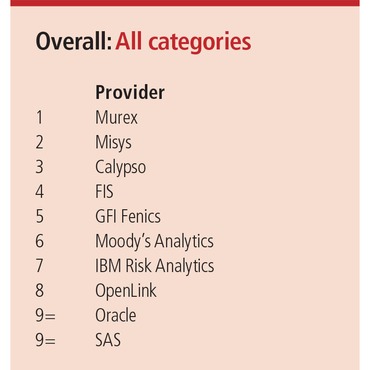
Asia Risk technology rankings 2016: Who rules the roost?
Financial institutions are having to adapt to a swathe of new rules as law-makers continue their "heavy-touch" approach to oversight and regulation. This year's tech rankings rate the vendors in Asia that offer solutions to these requirements - with Murex once again topping the chart. Misys and Calypso also showed strongly

Click for full rankings breakdown
 As Asian banks struggle with a raft of new regulations and market practices, they are increasingly turning to technology vendors to help them implement speedy and cost-effective solutions. New rules such as those for over-the-counter derivatives margining and clearing, a standardised approach for counterparty credit risk (SA-CCR) and the Fundamental review of the trading book (FRTB) are challenging not only in terms of their complexity, but also in the systems performance required for their calculations. Institutions that have made an early start and have the vision and resources are taking a strategic approach to the new regime, while others are having to make more tactical moves to meet deadlines and remain competitive.
As Asian banks struggle with a raft of new regulations and market practices, they are increasingly turning to technology vendors to help them implement speedy and cost-effective solutions. New rules such as those for over-the-counter derivatives margining and clearing, a standardised approach for counterparty credit risk (SA-CCR) and the Fundamental review of the trading book (FRTB) are challenging not only in terms of their complexity, but also in the systems performance required for their calculations. Institutions that have made an early start and have the vision and resources are taking a strategic approach to the new regime, while others are having to make more tactical moves to meet deadlines and remain competitive.
"A narrow majority of local and regional institutions are tackling the new regulatory requirements on a piecemeal basis, at least in a first stage, focusing primarily on compliance," says Guy Otayek, chief executive of Murex Asia-Pacific who is based in Singapore. Murex once again fought off competition from the other leading global derivatives trading and risk management vendors to take the top spot overall in the 2016 Asia Risk technology vendor rankings. Many other local and regional institutions, including larger firms, are looking at tackling the regulatory question more strategically, starting with the unification of data repositories and valuation engines for initial margin and credit and market risk capital needs.
 Guy Otayek, Murex
Guy Otayek, Murex
"These institutions' view is that regulators will expect consistency and transparency across all new capital charges and ratios, and putting in place a [unified] regulatory calculation engine is an efficient step in that direction. It also brings operational efficiency and much-needed improvements in computation performances. The institutions want to give themselves the means to manage proactively their funding and capital costs at the enterprise level," says Otayek.
Keeping abreast of the market and regulatory evolution requires significant investment in research and development on the part of vendors, says Otayek. As well as building this expertise into its products, Murex is increasingly sharing it with its clients via a service it calls RegCap Lab. For example, it has been advising a number of its clients on regulatory capital matters, and supporting their efforts to produce quantitative impact study results, or assisting them in their capital impact assessments by quickly running FRTB or SA-CCR computations on their positions.
A leading regional bank has just implemented Murex's MX.3 platform and is extending its enterprise risk and collateral management functionality to cover the calculation of SA-CCR exposure at default for all derivatives in its global markets and private banking activities for the January 2018 regulatory deadline. "In parallel, the bank is starting to plan its FRTB programme and as a first step is using our RegCap Lab to assess the scope [of the project]," says Otayek.
Misys, which came second in the rankings overall as well as topping the trading systems categories overall, is also working with clients on FRTB planning. "The high level of interest in FRTB stems from the gravity of the regulation," says Sadiq Javeri, product strategist for capital markets and risk at Misys, who is based in London. "There is a huge amount of work that needs to be done and banks in the region have realised this early."
Most of the interest is in the standardised approach rather than the internal model approach to FRTB and Misys has been communicating its plans to its clients for addressing the requirements. The company has already built the engine for the relevant calculations based on its Fusion architecture and is currently developing the user front-end. "As well as the engine, there is the large amount of data from the many thousands of calculations that needs to be aggregated. We have in-memory data aggregation technology that allows us to slice and dice all the calculations that come out of our pricing engine in real time," says Javeri.
With an increasing number of banks in the region now feeling the kind of budgetary and cost-to-income ratio pressures that US and European banks have faced in recent years, Misys has been advocating an incremental approach to business transformation whereby clients can implement components from its FusionCapital product suite to address particular issues on a step-by-step basis. "Clients can allocate specific but limited budget and time to implement a component and take the savings gained from that mini-transformation to fund the next layer of transformation," says Javeri.
Pre-package deal
Another tactic that many of the other major vendors are using to tackle the budgetary and regulatory deadline pressures is to pre-package as much compliance functionality as possible and to exploit online delivery mechanisms. For example, Misys is pre-packaging FRTB regulatory reporting, as well as specific trading and risk management functionality for treasury optimisation. "From one screen, treasury users can analyse and control balance sheet and funding risk, including directly executing hedging trades [based on gap analysis]," says Javeri.
But pre-packaging is a challenge in a region where business practices and regulations vary from country to country. This makes it difficult for financial institutions to find off-the-shelf vendor solutions that address their unique needs, says Mark Bell, head of South-east Asia and India for Calypso, who is based in Singapore. To address the challenge, Calypso, which came third overall in the rankings, has created a localisation programme that develops solutions specific to each country's particular regulatory requirements.
"The programme has succeeded largely because we integrate these local enhancements into our platform natively, so the features work out-of-the-box without any special maintenance. We don't rely on post-processing, workarounds or spreadsheets, which invariably create support headaches for the clients," says Bell.
For the Indian market, Calypso added support for the valuation approaches specified by the Foreign Exchange Dealers' Association of India and Fixed Income Money Market and Derivatives Association of India. It has also introduced comprehensive support for forex merchant transactions, which allowed its client IndusInd Bank to streamline processes that were previously operationally quite complex and labour intensive, says Bell. For the Philippines, Calypso has added support for the local sub-custody regulations, which allows banks to act as both the principal and an agent to manage the same transactions in a single solution - critical functionality for its client China Bank.
And in Hong Kong, Calypso helped OTC Clear, a subsidiary of HKEx, implement what Bell claims is an innovative risk management solution for handling cross-currency swaps. "The solution leverages the payment-versus-payment settlement capabilities within its local Hong Kong real-time gross settlement system, operated by the Hong Kong Monetary Authority," he says.
FIS, which came fourth in the rankings overall, believes that simplifying the way institutions engage with and manage the changes in the trading and risk environments is the best way it can help its clients meet current challenges. "Change today is driven by a need to innovate fast in a competitive market, with the added pressure of adapting to the regulatory changes," says Sanjay Varma, Asia-Pacific risk and compliance managing director for FIS, who is based in Singapore. "Our clients need to continuously balance their IT spend between these two priorities. We help our clients achieve this goal through a range of services including pre-packaging solutions, hosting the entire application, through to complete outsourcing of their applications and infrastructure. This allows our clients to focus on their end customer better while keeping abreast with the latest changes and overall ensuring better cost management."
Fenics, meanwhile, has seen a strong trend in the region to move to a co-ordinated e-commerce strategy. "This brings scalability and efficiency to the trading and sales arena," says Richard Brunt, managing director of Fenics, who is based in London. Fenics topped the FX pricing and trading system categories, and was also voted best innovative specialist vendor. To support the trend to e-commerce, Fenics has enhanced its suite of APIs to allow its users to integrate and use Fenics tools with their multi-asset systems or where they might have trading environments with systems from several vendors. Also, the Fenics Dealing Engine now enables users to automatically make FX options and precious metals prices on venues of their choice, including multi-dealer platforms, proprietary e-commerce platforms and internal trading platforms.
As well as enhanced APIs, Fenics is making its tools more accessible with a service it calls ‘Connectivity via the cloud'. "To save our customers connecting to multiple venues and liquidity providers and having to manage all their connections, we provide the required connectivity and adaptors as a service," says Brunt. This includes standardised modules with basic logic and workflow to minimise costs, while allowing for customisation where there is a clear business benefit, he says.
Among recent projects, Fenics helped a client with thousands of retail customers in North Asia trading FX option products by connecting its pricing and dealing engines to the client's existing e-commerce portal to provide automatic trading functionality to the end customers. For another client with a private banking and corporate franchise, Fenics provided automated dealing workflow with various internal and external distribution channels, including the client's wealth management platform and external multi-dealer venues, and featuring differing price discovery and trading workflows appropriate to the different channels.
Moody's Analytics, which topped the capital calculation and asset and liability management categories and came sixth overall, has been helping banks with the challenge of implementing models and processes compliant with the IFRS 9 accounting standard. "A major impact of the IFRS 9 standard is that impairment calculations are based on forward-looking risk parameters that directly affect the balance sheet. IFRS 9 requires macroeconomic forecasts, point-in-time credit risk models conditioned on the macro forecasts, and model and workflow management systems. Banks have had to either adapt existing models and systems or develop new ones," says David Hamilton, Singapore-based managing director, stress testing and credit risk analytics, Asia-Pacific, for Moody's Analytics. In this regard, the company recently provided a leading Hong Kong bank with a holistic IFRS 9 impairment solution, including standardised and customised models and standardised software for data management and calculations.
Stress testing also continues to be a challenge for Asian banks, says Hamilton. "Stress testing has gained more urgency as uncertainty about China's future economic growth and its effect on neighbouring Asian countries has increased. Like IFRS 9, stress testing is a major endeavour involving similar models and processes, as well as systems for reporting," he says. Moody's Analytics has been hosting webinars on the topic and discussing how its probability of default model can be effectively used for early warning of default risk.
Moody's Analytics is also aware of the need to make its tools as accessible as possible via several optional delivery mechanisms. "Our credit risk models are available as off-the-shelf subscription-based solutions, as customised and hosted models, as well as fully bespoke models. Our software solutions for workflow and model management in stress testing and IFRS 9 are designed to work with internal and external models written in different coding languages," says Hamilton.
Energy efficiency
In the commodities market, the past 12 months have seen a proliferation of smaller energy trading outfits across Asia. In Japan this is partly driven by the liberalisation of the power markets, but elsewhere it is a case of new trading firms seeing opportunities in the space and being hungry to take them, says Greg Moyle, head of sales, Asia-Pacific for OpenLink, who is based in Singapore. "The challenge this creates is that these traders need proper trading and risk management tools. They can't afford to get stuck using spreadsheets, but they don't have the manpower or budget to sink into huge technology systems," he says.
In response, OpenLink, which topped the commodities pricing and trading systems categories and came eighth in the rankings overall, has been offering technological expertise and has created packaged, off-the-shelf versions of its technology for these firms. "This means a more affordable, compact solution and also a quicker implementation time, which is essential for a new player raring to get going. We've delivered systems in around four months, but we're confident we can get that down to three or even two," says Moyle. Last year, Australian company United Petroleum selected OpenLink's RightAngle energy trading and risk management solution for the new oil trading operation it was establishing in Singapore.
With budgets everywhere under pressure, even at the big energy trading organisations. OpenLink has partnered with Fujitsu to deliver its solutions through the cloud. "This is more affordable, as it doesn't require clients to maintain an in-house IT team. By standardising and pre-packaging the software we can also bring the cost down further, opening the functionality up to more players, though some will still always want or need the customisation we offer," says Moyle.
Cloud-based delivery also means customers can keep their software up to date more easily. "It used to be that a significant product upgrade meant starting the implementation process anew each time, as a result of which some customers were tempted to skip a few versions to reduce that downtime. But with cloud delivery there is no need to send a team out into the customer's server room each time, which makes it easier for customers to stay up to date," says Moyle.
The issues that financial institutions have faced over the past 12 months are not going away any time soon, and the indications are that banks and others will rely increasingly on technology vendors to meet the challenges. As Otayek of Murex says: "Institutions in Asia-Pacific are looking to develop trusted partnerships with technology providers and are expecting [technology firms] to step up and play an advisory role to help them develop a long-term technology strategy to cope with the avalanche of regulatory changes and market transformations that are unfolding." Next year's Asia Risk rankings will no doubt reflect which vendors are rising to the occasion.

Only users who have a paid subscription or are part of a corporate subscription are able to print or copy content.
To access these options, along with all other subscription benefits, please contact info@risk.net or view our subscription options here: http://subscriptions.risk.net/subscribe
You are currently unable to print this content. Please contact info@risk.net to find out more.
You are currently unable to copy this content. Please contact info@risk.net to find out more.
Copyright Infopro Digital Limited. All rights reserved.
As outlined in our terms and conditions, https://www.infopro-digital.com/terms-and-conditions/subscriptions/ (point 2.4), printing is limited to a single copy.
If you would like to purchase additional rights please email info@risk.net
Copyright Infopro Digital Limited. All rights reserved.
You may share this content using our article tools. As outlined in our terms and conditions, https://www.infopro-digital.com/terms-and-conditions/subscriptions/ (clause 2.4), an Authorised User may only make one copy of the materials for their own personal use. You must also comply with the restrictions in clause 2.5.
If you would like to purchase additional rights please email info@risk.net
More on Rankings
TP ICAP: leveraging a unique vantage point
Market intelligence is key as energy traders focus on short-term trading amid uncertainty
GEN-I: a journey of ongoing growth
GEN-I has been expanding across Europe since 2005 and is preparing to expand its presence globally
Bridging the risk appetite gap
Axpo bridges time and risk appetite gaps between producers and consumers
Axpo outperforms in the Commodity Rankings 2024
Energy market participants give recognition to the Swiss utility as it brings competitive pricing and liquidity to embattled gas and power markets
Hitachi Energy supports clients with broad offering
Hitachi Energy’s wide portfolio spans support for planning, building and operating assets. Energy Risk speaks to the vendor about how this has contributed to its strong Software Rankings performance in 2024
Market disruptions cause energy firms to seek advanced analytics, modelling and risk management capabilities
Geopolitical unrest and global economic uncertainty have caused multiple disruptions to energy markets in recent years, creating havoc for traders and other companies sourcing, supplying and moving commodities around the world
ENGIE empowers clients globally to decarbonise and address the energy transition
In recent months, energy market participants have faced extreme volatility, soaring energy prices and supply disruptions following Russia’s 2022 invasion of Ukraine. At the same time, they have needed to identify and mitigate the longer-term risks of the…
Beacon’s unique open architecture underlies its strong performance
Recent turmoil in energy markets, coupled with the longer-term structural changes of the energy transition, has created a raft of new challenges for market participants







